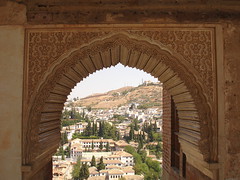 1492 is a date best know to most of us as the year in which that intrepid Italian explorer Christopher Columbus set sail for India as a viceroy and admiral for the Spanish monarchs Ferdinand and Isabella.
1492 is a date best know to most of us as the year in which that intrepid Italian explorer Christopher Columbus set sail for India as a viceroy and admiral for the Spanish monarchs Ferdinand and Isabella.
However 1492, is also the year in which Mohammed XII, the last Muslim ruler in Al-Andalus, was exiled to northern Africa by those self same monarchs.
With Boabdil’s exile came the end of a Muslim civilisation that for almost 800 years had welcomed the participation of Christians and Jews and created a unique culture in the region.
In its place came a religious fanaticism and a zealous determination to “purify” Spain for Christianity, which led not only to the ousting of Muslim and Jewish culture in Spain, but ultimately, via Columbus, to the end of the native culture of the Americas.
I think of this, because both these momentous events took place in the Hall of The Ambassadors, in the palace of the Alhambra in Granada .
As Boabdil went into exile in January 1492, so Colombus entered that very same room, that very same month, to seek sponsorhip for his epic voyage.
In today’s Spain, it is hard to imagine that such a time ever existed. The presence of Catholicism is so powerful, especially perhaps in Seville, that it has a sense of permanence about it, an eternal aspect that has no beginning or end. The idea of a Muslim stronghold in Spain seems fanciful and improbable these days.
Yet from AD 711 the muslims were in the south of Spain, in Al Andalus, and the Alhambra is a beautiful and enchanting monument to the culture they developed and sustained there.
It’s difficult to know where to begin when trying to describe it, for there is so much to describe, so much beauty to behold, so many intricate details to decipher, that it is overwhelming.
So perhaps it is best simply to give an impression of a few parts of it and leave the rest for you to discover yourself.
The Court of the Myrtles was for me a truly mesmerising place, not least because of the light. The courtyard is open to the sky, which allows the light to glimmer off the marble floor and the white plaster walls which are elaborately engraved with texts from the Koran.
In the centre, a long dark pool relflects the sky, a symbol of the connection of the earth and the heavens, of man and God. It is a place to rest and to contemplate. To open yourself up to God and to the world, to the power of nature and the spirit.
Perhaps at the time of its contruction it was felt that such a place was a necessary haven for visitors on their way for an audience with the Sultan, for such visitors would have had to have passed through here on their way to the dark and intimidating Hall of the Ambassadors.
It takes a while for your eyes to adjust to the darkness of the Hall, to come from that light into this oppressive darkness.
It’s an optical effect that was very deliberately constructed. A wan light enters the room via small deeply set windows, but it is barely enough to lighten the room which is covered in a huge and elaborately painted dome. As you adjust your eyes you turn to a larger window which looks out over the hills of Granada. The view is obscured because the harshness of the light outside is almost blinding. It is impossible to see.
This is the window in which the Sultan sat during his audiences. As his visitors squinted in the darkness they would have seen only his silhouette. A foreboding and intimidating sight, I’m sure.
From his vantage point in the light however, the Sultan would have been able to see everything and everyone in the room.
As psychological intimidation goes, it’s a pretty neat trick.
As the setting for two momentous events in world history, the Hall of the Ambassadors is certainly every bit as imposing as you could imagine.
These days though, the history seems forgotten.
As I wandered about among the coachloads of tourists, it was the sheer beauty of the place that seemed to captivate and hold people’s attention most.
All thoughts of wars, conquests and exile; of politics and religion, fanaticism and intolerance, seemed strangely unfitting for such exquisite surroundings.
And perhaps this is the best way to look at the palace today – as a symbol of man’s attempt to express, not power, but beauty. To convey that oneness with earth and sky that we see in the courtyards of the Alhambra.
As we struggle today to find a common ground between religions, perhaps it is better simply to walk out of those dark, brooding halls of power and head back into the bright, quiet, scented courtyards filled with roses and myrtle.
For the Alhambra was a place for contemplation and pleasure, and it is so easy to forget that light and that beauty when you are lost in the darkness of power.